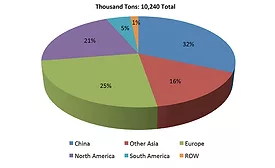Home » Keywords: » sealants in woodworking
Items Tagged with 'sealants in woodworking'
ARTICLES
The Asia-Pacific region dominates the global wood furniture market, accounting for over 45% of market share in 2018.
Read More
Market Trends: China Leads Adhesives Growth
Growth of adhesives and sealants in the Asia-Pacific region is expected to expand by 7%.
November 1, 2015
Top 5 News that Sticks
Momentive Name Change Garners Most Interest
Readers were most interested in a name change for Momentive Specialty Chemicals last week.
December 15, 2014
Top 5 News that Sticks
Dow Divestments Remain Top News
Dow’s announcement regarding its divestment plans remained in the top position last week.
December 8, 2014
UV/Vis Energy-Cure Adhesives and Sealants: Industry Trends, Chemistry, and Packaging
Applications for energy-cured coatings, adhesives and sealants have grown rapidly.
November 1, 2014
Formaldehyde and Health Risks
Negative health effects caused by formaldehyde can be avoided through safe ventilation practices and detection instruments.
July 1, 2013
Keep the info flowing with our newsletters!
Get the latest industry updates tailored your way.
JOIN TODAY!Copyright ©2025. All Rights Reserved BNP Media.
Design, CMS, Hosting & Web Development :: ePublishing








